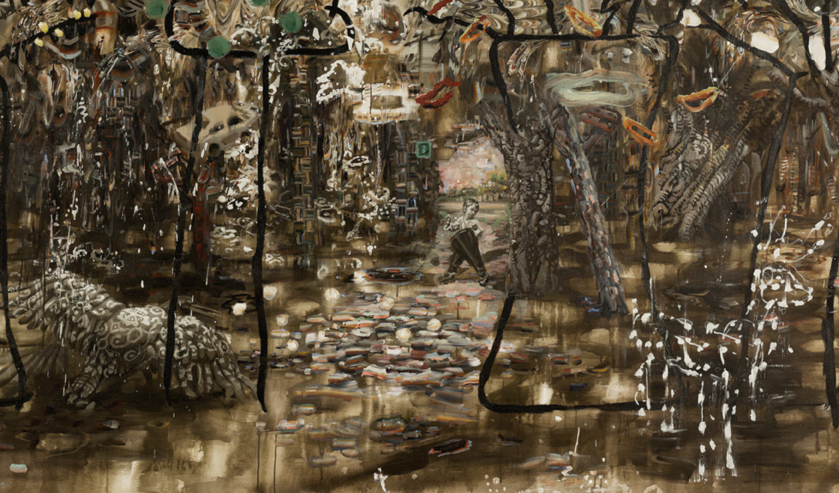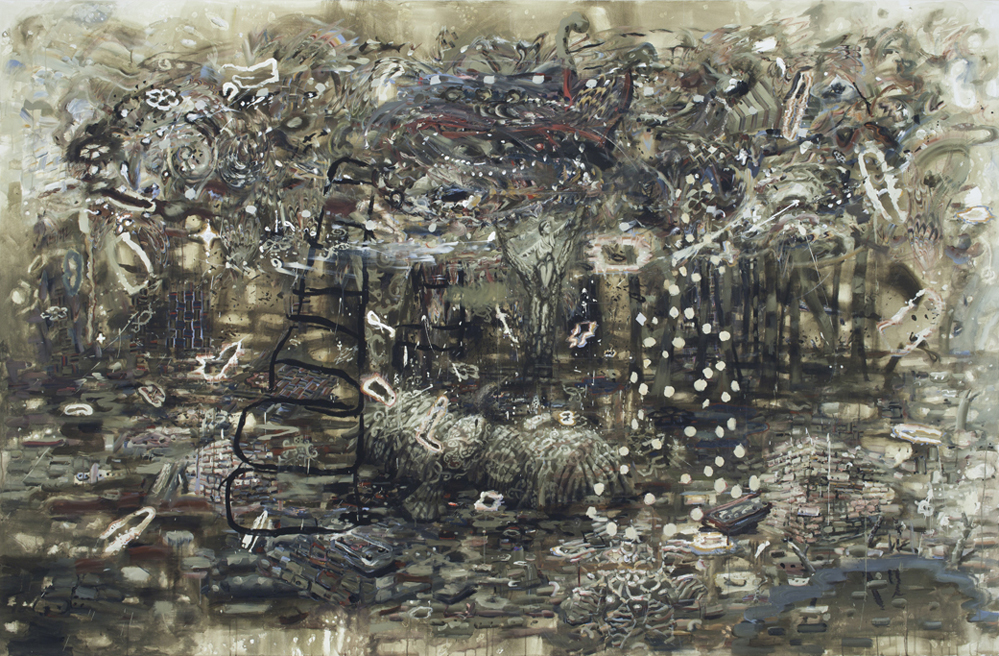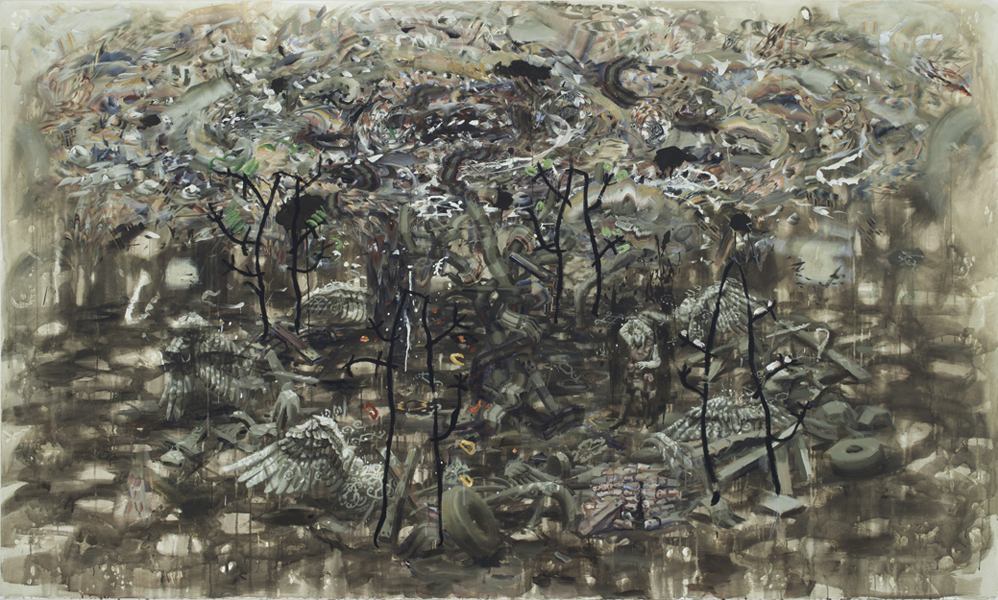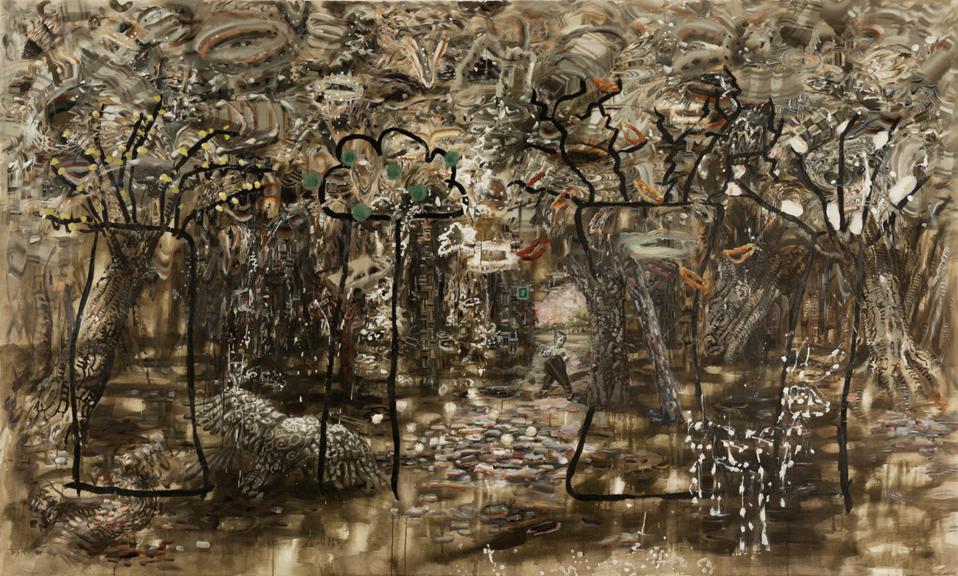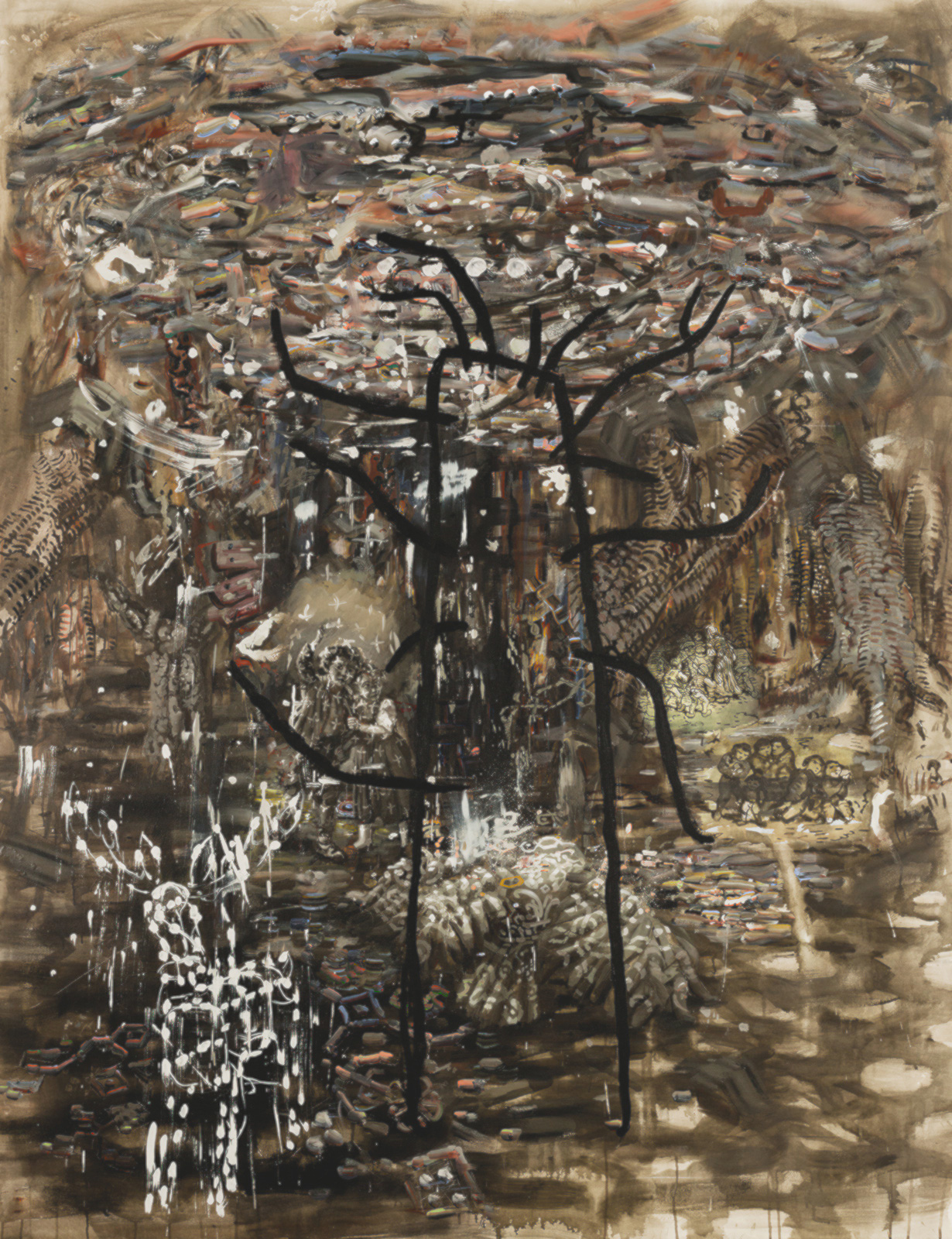Dropped From The Calendar
Carol Wainio
new paintings
November 14, 2014 - January 10, 2015
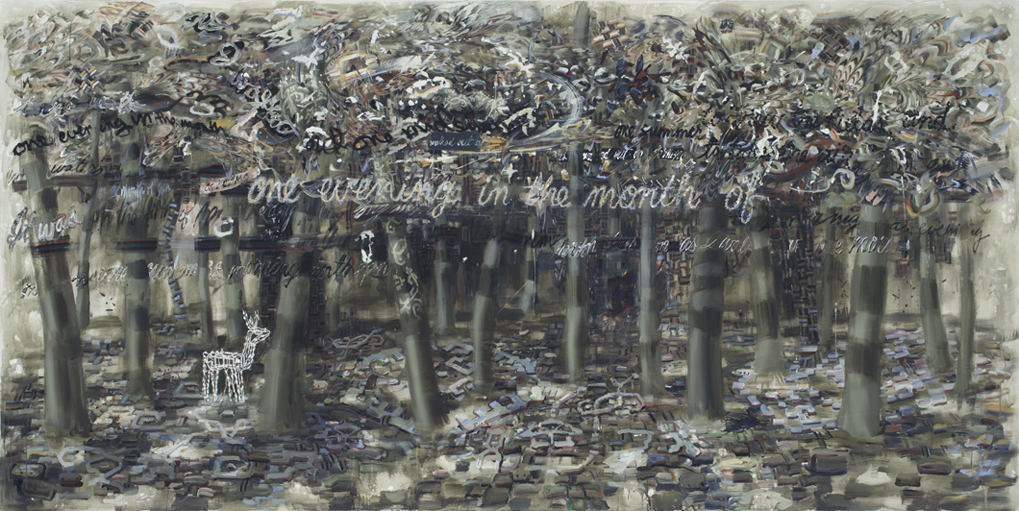
Carol Wainio: Long Ago, Far Away, Wish…
I make pictures, and very occasionally, write words. Sometimes failed words produce pictures. Sometimes pictures need words. Some words, like those written by Walter Benjamin almost a century ago, return again and again, like old stories, and remain powerful, poetic frameworks for wondering about present and future. Here, with a few of them, I wonder aloud and try to ‘picture things’…
In “On Some Motifs in Baudelaire” and “The Storyteller”, Walter Benjamin evokes the mentalités of an earlier time. Central to his insight into the modern moment is his notion of “experience” – a word that for most of us means ‘what happens to us’. But Benjamin had something specific in mind when he spoke of experience. And it’s appropriate that his definition reflects its ‘means of production’, rather than its content. Experience was what occurred in slower times when sensory matter slipped, un-registered, into memory.
“Where there is experience…certain contents of the individual past combine in the memory with material from the collective past”. “Rituals, with their ceremonies and their festivals…kept producing the amalgamation of these two elements of memory over and over again. They triggered recollection at certain times and remained available to memory throughout people’s lives.”
Benjamin saw this kind of experience overtaken by a kind of self-consciousness resulting from the ‘shocks’ of industrialism, urbanism, technology, and the sudden speeding up of life – things which necessitated anticipatory awareness. One had to be ready to be jerked to attention, responding to machines that brought ‘work’ within reach and quickly removed it, sometimes along with a finger or hand. Citing Freud, Benjamin imagines shock’s psychic side effects. “The more readily consciousness registers shocks”, “the less likely they are to have a traumatic effect”, but so too, “the less likely they are to enter long experience”. A shift in the fabric of life was occurring. He described this “shrinking of experience” as “disenchantment”.
Interested in vernacular as much as high art, Benjamin collected fairy tales. This passage in “The Storyteller” suggests why:
The reception of a story…requires a state of relaxation which is becoming rarer and rarer… boredom is the apogee of mental relaxation… the dream bird that hatches the egg of experience. A rustling in the leaves drives him away. His nesting places – the activities that are intimately associated with boredom – are already extinct in the cities, and are declining in the country as well… lost because there is no more weaving and spinning to go on while they are being listened to. The more self-forgetful the listener is, the more deeply is what he listens to impressed upon his memory…This is how today it is becoming unraveled at all its ends after being woven thousands of years ago in the ambience of the oldest forms of craftsmanship.
I thought of these words while reading picture books to young children - the slurred sense of time, rituals of repeated images and stories at regular intervals, children who see their first images as both forever and true - an early developmental moment that evokes an historical one. Benjamin again in The Storyteller:
There is nothing that commends a story to memory more effectively than that chaste compactness which precludes psychological analysis…And the more natural the process by which the storyteller foregoes psychological shading, the greater becomes the story’s claim to a place in the memory of the listener, the more completely it is integrated into his own experience, the greater will be his inclination to repeat it to somebody else, sooner or later…
He describes a kind of copying arising in conditions of scarcity – one which honoured, rather than evacuated, earlier models or patterns (as distinct from notions of “original”). So too, in early fairy tale, the magical power of transformational objects (and representations) arose from their scarcity and inaccessibility. The fine boots that helped a clever cat transform his peasant master into a prince are a hinge pivoting backwards and forwards – from a past where goods were rare, and change in status impossible, to a present where status is routinely achieved through commodities, and its magical “aura” diminished.
Testament to narrative’s adaptability, ‘animal helper figures’ like Puss in Boots took on new roles in later centuries, becoming salesmen for consumer products – marketing smaller, cheaper changes in status as social mobility increased. Countless incarnations of Le Maître Chat sold matches, soap, shoe polish, or wool. Le Petit Poucet hawked flashlight batteries – useful for finding one’s way out of the forest where hungry peasants had abandoned children they couldn’t feed.
For centuries, fabled characters from these narratives walked down through the farm fields of the past into the cities of early advertising, ‘illustrating’ a larger, and very real story of social transformation, with pictures first reproduced by hand, then mechanically. Early methods of hand copying echoed Benjamin’s sympathy for pre-modern aural stories, expressed here: “Experience which is passed on from mouth to mouth is the source from which all storytellers have drawn. And among those who have written down the tales, it is the great ones whose written version differs least from the speech of the many nameless storytellers”. Words like these problematize his well-known writings on mechanical reproduction. And early hand copied illustrations themselves ‘illustrate’ Benjamin’s suggestion for stories; tiny, stiff figures lacking in artistic shading, simultaneously “original” and “copy”, occupy an uneasy intersection between Benjamin’s views on visual “mechanical reproduction” and the kind of copying in storytelling. Later, as bits of commodified labour, engraved copies of mass produced vagabonds migrated between different narratives, identical figures appearing in Hansel and Gretel and Le Petit Poucet – interchangeable ‘products’ of a burgeoning story ‘industry’ coinciding with the invention of romanticized childhood.
While scarcity, traditional farm labour, and hierarchical social structures of fairy tale remain in our distant past, the scythe, ox and plough seen in 18th century illustrations of Perrault – are still visible in parts of the globe where these conditions persist - where European modernism is ‘reproduced’. Western “long ago” meets “far away” in new(s) stories.
Old narratives are full of tropes in which a long absent lover returns unrecognized, where clothing is scarce, proscribed, and narratively significant (“She put on her robes of green…”). Disconnected from our past and at war with history, we too may encounter (and fail to recognize) our former selves when disguised in an “other’s” clothing – robes of Afghan blue, for example. In these “meetings on the road” or “knocks at the door”, our forgotten tales encounter a contemporary variant – which we, like maidens in forgotten ballads, fail to recognize.
In the contemporary far away, the “shock of the new” may produce societal earthquakes, while in the digital post-industrial west, Benjamin’s ‘shock’ has become background. Smaller, cheaper forms of ‘shock’ are even self-administered to ward off a boredom so old and foreign it feels like death. “Thinking about the past or imagining the future is… a uniquely human trait. But… people who were asked to spend a few minutes alone with their thoughts disliked it so much that they would zap themselves with electricity,” researchers reported recently. We know this already – the clicks that ward off dreaded blank spaces, the lost ability to gaze out the window of a train…
Benjamin’s factory ¬– where work is “sealed off from experience” has inched closer to his description of gambling, “where no game is dependent on the preceding one”; ‘winning’ now ascendant, from commerce to culture. But the financier, smartphone addict, or reality contestant’s desires are not “wishes”. A wish lives in experience:
The earlier in life one makes a wish…the further [it] reaches out in time, the greater the hopes for its fulfillment…it is experience that accompanies us to the far reaches of time, that fills and articulates time. Thus, a wish fulfilled is the crowning of experience. In folk symbolism, distance in space can take the place of distance in time; that is why the shooting star… has become the symbol of a fulfilled wish.
Psychology offers other metrics of shrinking experience. Now in eclipse like weaving and spinning, handwriting is subject to forensic study: In another psychology experiment, pre-literate children were asked to reproduce a letter by drawing it freehand on blank paper, tracing it, or typing the appropriate key. Only the freehand drawers “exhibited increased activity in three areas of the brain”. “When we write, a unique neural circuit is automatically activated…There is a core recognition of the gesture” which echoes other such gestures – from the common architecture of stories retold across early empty landscapes, to the rewriting of architectural types – silver spired churches or prairie grain elevators – variable, yet similar figures that once punctuated blank, white geographies, and which we come to recognize as we do different handwriting.
In the old world of experience, Benjamin observed, “spaces for recollection” (like pages for creating letters) had been “left blank”. But “the bells, which once played a part in the holidays, have [now] been dropped from the calendar…”
Almost a century later, we might wonder whether the calendar itself is in eclipse. Synonymous with “labours of the months”, the seasons have worn grooves into life’s structures over centuries. Old ballads began with time and season (“it was on a May morning”; “as I walked out one summer’s evening”), and were anchored in the reliable, reassuring narrative of recurrence around which past and future, self and society, human and nature, clustered and coalesced. Even now, the seasons may be one of the few drawings young children still make, before that space is overwritten by digital devices. But this ground, this fundamental narrative, is eroding too. Along with the small shocks of self-conscious, self-administered interruptions, the larger “shocks” of severe, unpredictable “weather events” and increasingly “unseasonable weather” associated with climate change add to a diminishing ability to absorb the physical world as “experience” in Benjamin’s sense. While potentially calamitous, how much more meaningful may be the interior loss of those quiet, unconsciously absorbed rhythms - the reliable return of spring, monsoon, or long winter? What will happen when ‘the seasons’ as metaphor or a kind of ‘grand récit’ is “unraveled at all its ends”?
Sometimes it seems that the ‘shock’ Benjamin first articulated so long ago leaves us constantly wakeful, yet under a deep sleeping spell. And while the great literary critic worried about the impact of shrinking experience on poets, the Marxist hinted at larger impacts, now more pronounced than when he sketched them out. It remains to be seen whether we can create a space in which to wish for a happy ending …
-- Carol Wainio, November 2014
In his essay, On Some Motifs in Baudelaire, Walter Benjamin observes that modern Westerners, who have lost their capacity for experience, feel as though they have been “dropped from the calendar”. Quoting Baudelaire, he notes the violent self-consciousness with which the sound of bells accosted revolutionary listeners after they had lost their ages old cues for the “blank spaces” of recollection.
While ‘blank spaces’ are now under assault from many directions, and while the physical, environmental effects of the loss of reliable seasons are significant enough, one wonders how much more meaningful will be the psychic and social loss of these fundamental rhythms and narratives.
These paintings consider, with a kind of elegiac wonder, both the past, and the now constant, momentary, wakeful sleeping spell with which we approach the future.
Carol Wainio was born in Sarnia, Ontario in 1955. After studies at the Nova Scotia College of Art and Design and the University of Toronto, she earned an M.F.A. from Concordia University in 1985. She taught in the Visual Arts Department at the University of Ottawa from 1987 to 1989 and was an assistant professor in the Department of Visual Arts at Concordia from 1989 to 1998. She lives and works in Ottawa, where she is an adjunct professor at the University of Ottawa.
Wainio's recent exhibition The Book, curated by Diana Nemiroff for Carleton University Art Gallery, contains works from 2002-2010 and toured extensively in Canada. A comprehensive hardcover catalogue is available. An exhibition of new work, Old Masters, took place at the Kitchener Waterloo Art Gallery, March 8 - April 28, 2013. Wainio is a 2014 recipient of the Governor General's Award in Visual and Media Arts.
A catalogue of new work, with essays by Jeet Heer and Carol Wainio, is forthcoming.







